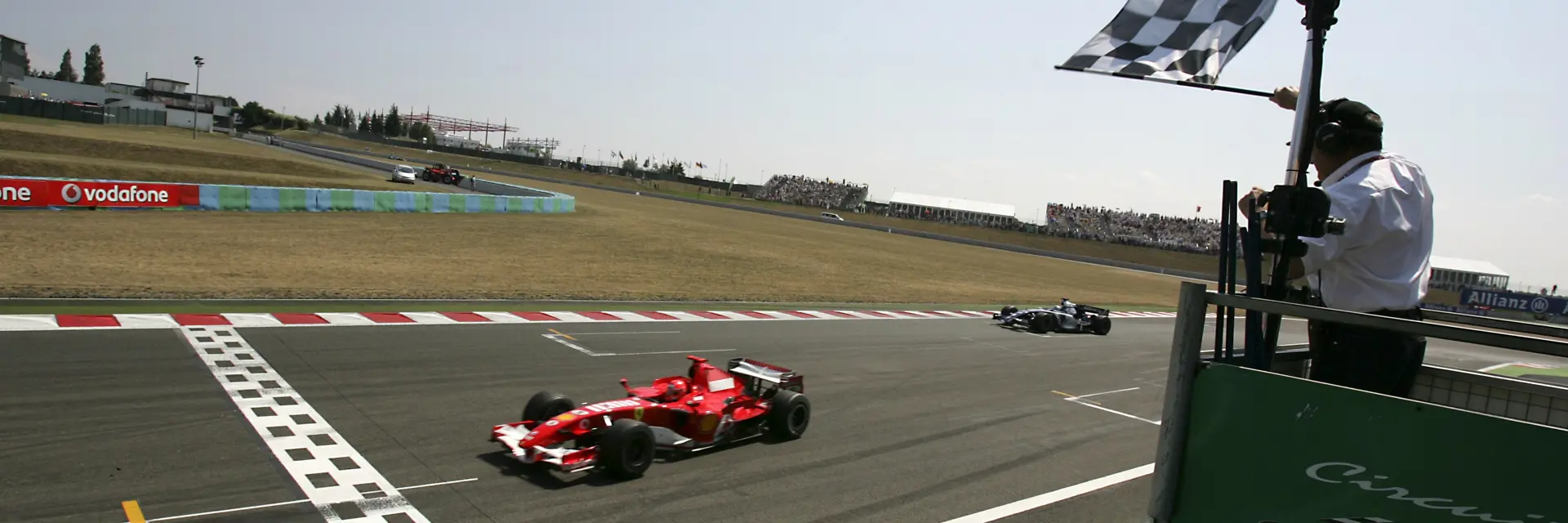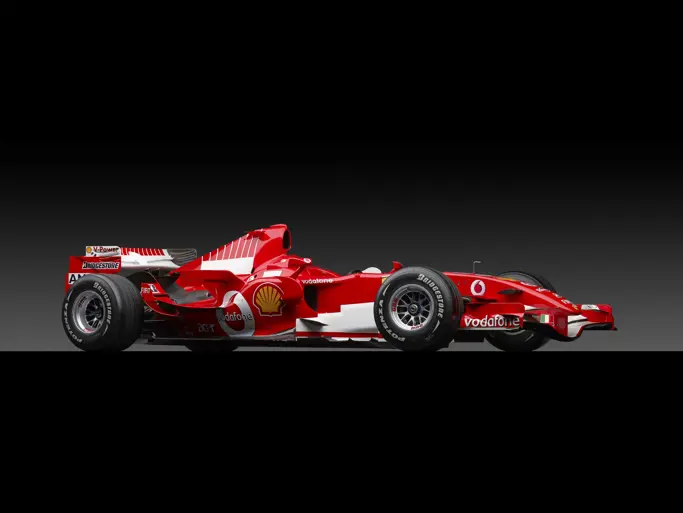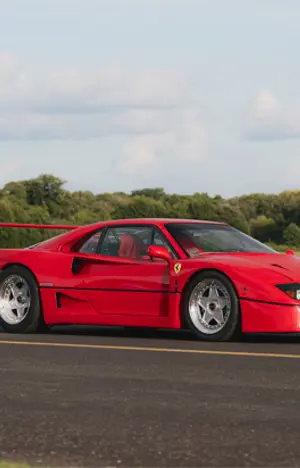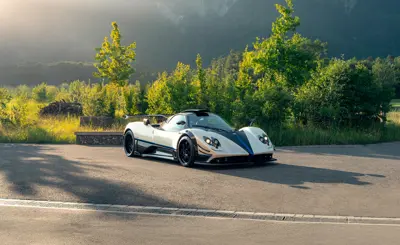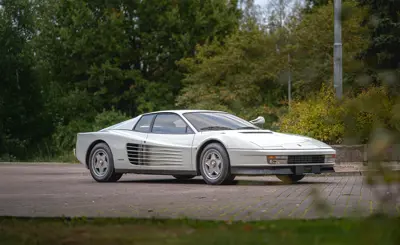The alchemy of Ferrari and Michael Schumacher has gone down in history as one of the greatest sporting partnerships of all time. It represented a high point in Formula 1’s relentless pursuit of performance and technical excellence. This month, RM Sotheby’s will auction the car in which Schumacher fought his final campaign with Ferrari.
The 2006 season proved to be 37-year-old Schumacher’s swansong with his beloved Scuderia. It was a year in which the seven-time world champion fought some of the toughest and most exciting duels of his racing life against the hungry and youthful Fernando Alonso, 24. The Ferrari 248 F1 car you see here, chassis 254, which will be sold by RM Sotheby’s via Sealed bid on 19 November, is among the winningest Schumacher machines in existence, having taken a total of five grand prix victories and eight total podiums. It is the car that marked the bookend of Ferrari’s most dominant era in Formula 1, and directly inspired the generation of drivers that followed in Michael’s red suede racing boots.

Ferrari is the only team to have been in Formula 1 since the world championship’s 1950 inauguration, and in the process, it has created an iconic and passionate following that surpasses all other automotive brands and sporting équipes. Nevertheless, it has endured more than its fair share of drought, misfortune, and pain. The 1980s were a period of decline for the Prancing Horse’s sporting department (for the road car division, which produced the 288 GTO, Testarossa, and F40 that decade, not so much). Ferrari hadn’t won a Drivers’ Championship since Jody Scheckter’s in 1979, or a Constructors’ title since 1983. Fiat patriarch Gianni Agnelli made his first move to stop the rot by appointing former Ferrari team principal Luca di Montezemolo as company president in 1991. Montezemolo, in turn, hired Jean Todt in 1993 to head the race team.
The quiet Frenchman’s background was in rallying and endurance sports cars, and he successfully set about reorganizing the Scuderia from the ground up, instilling a culture of unity, absolute professionalism, and a winning mentality. He made some crucial outside hires for 1996, and together they became known as the ‘dream team’: technical director Ross Brawn and designer Rory Byrne both came from the Benetton team, as did 1994 and 1995 World Champion Michael Schumacher.
Todt was the conductor of this orchestra. He adored Schumacher’s work ethic; his quest for improvement was relentless, as was his commitment to personal performance. And above all, Michael was a team player. Schumacher and his engineers and mechanics won and lost together. Aided by an extremely generous budget from sponsor Philip Morris International, Scuderia Ferrari had the tools and the talent to take on all comers. They won five consecutive Drivers’ World Championships together between 2000 and 2004 and six consecutive Constructors’ World Championships from 1999 through to 2004.

The dominance faltered in 2005, with Renault and McLaren, and their respective young hotshots Alonso and Kimi Räikkönen, outscoring Ferrari and Schumacher. The F2005 proved recalcitrant and unable to extract maximum performance from its Bridgestone tires. Ferrari had some serious work to do for 2006. Consequently, from mid-2005 onwards, the team shifted its focus towards developing a car compliant with the upcoming regulations. The formula shifted from 3.0-litre V-10 engines to 2.4-litre V-8s. This would prove to be the last generation of normally-aspirated engines, before much quieter turbo hybrids were introduced in 2014. The 2006 season would, in fact, witness the highest rev limits in F1 history—in the Ferrari’s case well over 20,000 rpm. It elicited a baleful, ear-shattering wail as it tore through the rev range.
The new Ferrari was christened 248 F1, in acknowledgement of the new capacity and the total number of cylinders. The 90-degree Type-056 engine was the first V-8 unit to power a Ferrari grand prix car since the championship-winning 158 of 1964. Initially boasting around 730 brake-horsepower, this would increase to as much as 785 brake-horsepower by season’s end as the engineers pushed its limits. Along with its seven-speed longitudinal gearbox, it slotted into a form-fitting chassis of similar dimensions to the outgoing F2005 but optimized within the context of the new regulations. Significant aerodynamic improvements had been made to the sidepods, deflectors, engine cover, diffuser, and floor. Todt’s orchestra comprised chassis chief designer Aldo Costa and engine chief designer Gilles Simon, while Paolo Martinelli was responsible for the engine department, Rory Byrne consulted on the design and development of the chassis, and Ross Brawn remained in overall technical charge. For 2006, Felipe Massa replaced Rubens Barrichello as Michael Schumacher’s wingman.

Chassis no. 254 was the fifth of eight cars constructed that season and made its track debut on 4 April 2006 at Italy’s Vallelunga circuit at the hands of test driver Luca Badoer. Further pre-season tests were conducted by Schumacher and teammate Massa, with some 3,900 kilometres being accumulated prior to the chassis’ race debut at the fourth round of that year’s world championship, at Imola. Schumacher had been on pole for the curtain-raiser in Bahrain and finished the race runner-up to Alonso, while Malaysia could only offer up 6th place, and in Australia, struggling with cool tires, Schumacher lost control and slammed into the barriers. Chassis 254, drafted in for the San Marino Grand Prix, brought a lot more luck.
Chassis 254 topped its maiden qualifying session. It was a significant milestone, for it saw the German surpass Ayrton Senna’s longstanding record of 65 pole positions; a moment made all the more emotional due to it happening at the circuit where the great Brazilian lost his life. The race proved one of the most memorable of Schumacher and Alonso’s dogfights. Whereas Alonso had managed to keep his pursuer a few inches behind, lap after lap, all the way to the finish at Imola in 2005, this time the positions were reversed and it was the Ferrari that led the blue and yellow Renault to the chequered flag.

Michael’s second win of the season came two weeks later, again in chassis 254, marking the final of Schumacher’s five European Grand Prix victories at the Nürburgring. Following a sequence of three 2nd-place finishes at the Spanish, British, and Canadian GPs, chassis 254 next appeared at Indianapolis. Here, Schumacher won the United States Grand Prix from pole. Massa completed a one-two. With Schumacher also scoring the fastest lap, it was a perfect and utterly dominant weekend. Chassis 254 did the business again at the next race, with the car and France’s Magny-Cours circuit providing Michael with the 68th and final pole position of his career. He romped to victory in the race.
The Ferrari’s fifth and final win came at Hockenheim on 30 July 2006. Here, Schumacher qualified 2nd behind Raikkonen and won the race, with Massa’s P2 giving the Scuderia another maximum points haul. The 2006 German Grand Prix was the final time Schumacher triumphed in front of his adoring countrymen. The chassis was essentially retired after the next race, in Hungary, where Michael sustained collision damage. The car saw out the rest of the season as the spare, and Schumacher received a new chassis.
Michael tearfully announced his retirement in Autodromo di Monza’s press conference room on 10 September, having just won the Italian Grand Prix and made his trademark podium leap above the 100,000 fervent Tifosi that were crammed along the start/finish straight below. Italy’s cathedral of speed had never seen such an outpouring of faith and devotion.

With Schumacher winning in China, he and Alonso were tied on points with two rounds to go. But in Japan, disaster struck. Michael was leading with Fernando in his mirrors when the Ferrari’s powerplant expired in a puff of white smoke; it was Schumacher’s first engine failure in six years. Schumacher needed to win in Brazil. It was the final race of 2006 and would be Schumacher’s last for Ferrari…and, in theory, of his F1 career. Alonso only needed a point to retain the world title. Nothing seemed to go to plan for our hero: Michael qualified P10 due to a fuel pressure glitch, then he caught a puncture on lap one. If it seemed over before, it was now…but the fates hadn’t banked on Schumacher’s never-say-die determination. What followed was classic Michael, scything his way back up the field, making a symbolic pass on his replacement at Ferrari, Räikkönen, and crossing the finish line P4, only two places behind Alonso. It was a virtuoso performance, and a mighty comeback just shy of the full Hollywood ending. He bowed out with 91 grand prix victories to his name.
Chassis 254 played a central role in Schumacher’s legacy, recording five of his seven wins in 2006, three out of four pole positions, three further 2nd-place finishes, and four fastest laps, making it one of the most awarded chassis of Michael’s storied career. The car was also used in a demonstration drive by Michael during his final appearance as a Ferrari driver at that year’s Finali Mondiali, Ferrari’s winter motorsport festival, which was held at the Autodromo di Monza on 29 October 2006.

Just as one chapter ended at Ferrari, another one started. Kimi Räikkönen, who had taken over Schumacher’s seat for the 2007 season, was entrusted with chassis 254 for four days of testing at Vallelunga in late January as part of his pre-season preparations. While not definitively known, it is believed to be the first Ferrari F1 car Räikkönen ever drove. To date, the Finn remains Ferrari’s most recent World Champion, taking that 2007 title.
Michael Schumacher’s legacy has inspired every Formula One driver on the grid today, and every other kid racing go-karts in the ‘90s and ‘00s. Overshadowing the dynasties of even Jim Clark/Lotus and Ayrton Senna/McLaren, his marriage to Ferrari has been the blueprint for all the most successful team and driver pairings since: Sebastian Vettel/Red Bull Racing, Lewis Hamilton/Mercedes, and Max Verstappen/Red Bull Racing have been directly influenced by the magic they witnessed between Schumacher, his dream team, and his bright red machine.
For generations of racing enthusiasts, collecting connoisseurs, and the world champions following in Michael’s wheel tracks, the Ferrari 248 F1 is among the most evocative of competition cars ever built.


